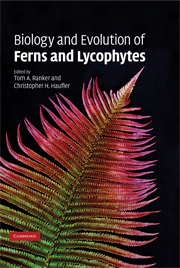Book contents
- Frontmatter
- Contents
- List of contributors
- Preface
- Acknowledgments
- Part I Development and morphogenesis
- Part II Genetics and reproduction
- 4 Population genetics
- 5 Antheridiogens
- 6 Structure and evolution of fern plastid genomes
- 7 Evolution of the nuclear genome of ferns and lycophytes
- Part III Ecology
- Part IV Systematics and evolutionary biology
- Index
- References
5 - Antheridiogens
Published online by Cambridge University Press: 11 August 2009
- Frontmatter
- Contents
- List of contributors
- Preface
- Acknowledgments
- Part I Development and morphogenesis
- Part II Genetics and reproduction
- 4 Population genetics
- 5 Antheridiogens
- 6 Structure and evolution of fern plastid genomes
- 7 Evolution of the nuclear genome of ferns and lycophytes
- Part III Ecology
- Part IV Systematics and evolutionary biology
- Index
- References
Summary
Introduction
In homosporous ferns individual gametophytes are generally able to form both antheridia and archegonia. No genetic regulation that determines the sex of the haploid generation has been demonstrated. Growth, temperature, light conditions, environmental characteristics, soil conditions, and, in many cases, antheridia-inducing substances can influence the development of antheridia and archegonia (Voeller, 1964; Miller, 1968; Voeller and Weinberg, 1969). We can therefore describe homosporous ferns as having labile sex expression (Korpelainen, 1998).
The antheridia-inducing substances are called antheridiogens, and are products (hormone-like substances) of the metabolism of prothalli. The term antheridiogen characterizes the function but not the chemical composition. In the literature there is a variety of different terms for antheridiogen, for instance, A-substance (Döpp, 1950, 1959, 1962), antheridogen (Pringle, 1961), pheromone (e.g., Näf et al., 1975; Scott and Hickok, 1987), and hormone (e.g., Näf, 1962; Näf et al., 1975; Raghavan, 1989). Schraudolf (1985) distinguished between the pheromonal (effective on neighboring individuals) and the hormonal (effective within an individual plant) phase of antheridiogens. Here, we will use antheridiogen, the term that is favored in the literature.
History of discovery
Döpp (1950) was the first to discover a naturally produced substance that induces antheridia formation in young prothalli. He showed that substrate from maturing prothallial cultures of bracken (Pteridium aquilinum) induced antheridia formation in young prothalli of its own species and those of Dryopteris filix-mas. The same was true also when using aquatic extractions.
- Type
- Chapter
- Information
- Biology and Evolution of Ferns and Lycophytes , pp. 134 - 158Publisher: Cambridge University PressPrint publication year: 2008
References
- 24
- Cited by



